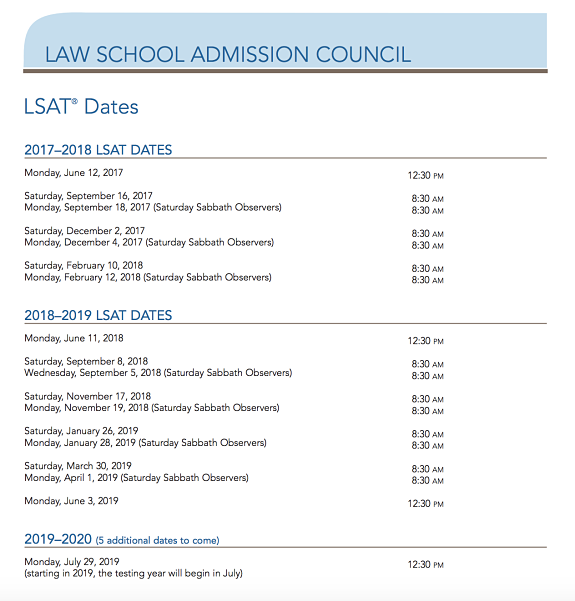New LSAT Dates for 2018
- by
- Dec 27, 2017
- Admissions, General LSAT Advice, LSAT
- Reviewed by: Matt Riley


In 2018, the Law School Admissions Council (LSAC) is making some changes to the LSAT schedule. Before 2018, and since time immemorial — well, technically, since the introduction of the current LSAT in 1991, but for most Millennial test takers, Nirvana has been played on classic rock stations for their entire lives and the first Bush Administration may as well be the middle ages — there were four LSATs in a given year. There would be an exam in February, in June, in either late September or early October, and then in December.
And this pattern held all the way through 2017, during which we were treated to tests on February 4th, June 12th, September 16th, and December 2nd. But with the turning of the calendar to 2018, LSAC is turning the page on its classic LSAT schedule. It’s making some radical changes. Let’s check them out:

OK, OK. If you just look at the 2018 exams, we’re not exactly seeing at a seismic shift. There are no real changes to the February and June exams. The September exam is a little bit earlier than usual. The biggest change is that the December exam has been scheduled a couple weeks earlier and will now be held in mid-November.
If you look at the 2019 dates, you’ll see more significant changes, and the slight change to the 2018 exam starts to make more sense. As we previously discussed, LSAC made some noise this year when it announced it would start administering six exams per year. A 50% increase from the aforementioned schedule of four exams per year! But in order to get a seamless transition to this new schedule, LSAC had to engage some clever calendar chicanery. The first year in which it will provide six exams is actually some new, made-up 2018-19 calendar year that spans from, I guess, June 11, 2018 to June 10, 2019. You’ll notice that the first exam given in Year 1 A.D. (After December test) is on June 11, 2018. And the sixth exam given in this year is on June 3, 2019. So they just barely got that last one in, but there will technically be 6 official LSATs administered in the made-up year of 2018-19.
But why did they make this seemingly arbitrary change? Well, right now, LSAC is fighting a war on two fronts. The first front was the precipitous decline in the number of LSAT takers and law school applicants. Now — thanks, perhaps, to the efforts of our real Commander-in-Chief — LSAC is finally making advances on that front, with test takers and applicants way up this year. The second front, however, involves the encroachment of the GRE as a viable alternative to the LSAT, as law schools are increasingly allowing applicants to take the GRE rather than the LSAT. Unfortunately for LSAC (which, to be clear, administers the LSAT and profits from students taking that exam, but neither administers nor profits from the GRE), it is very much losing ground on that front.
So rather than resting on its laurels and hoping that pre-law types get scared by the math sections on the GRE, LSAC is trying to make the LSAT a more appealing alternative to the GRE. And one way to do that is making it easier to take the LSAT — hence eventual increase in the number of LSATs administered per calendar year, made up as those calendar years may be.
But for the actual calendar year 2018, the schedule hasn’t changed that much, so our advice on when to take the test won’t change much either. Which is the “best” LSAT to take? No matter what, the answer to that question will always be the test you can dedicate the most study time to.
So take a look at the above schedule, and then take a look at the 2-4 months before each test date. Which 2-4 month time period will allow you the most time to hunker down and learn how to do the LSAT?
If you’re just now thinking about taking the February 2018 exam, well, you’re already a little late to that party. The February exam is a little more than a month away, so it may be too late for you to dedicate adequate study time to it. But if you’ve studied for the LSAT in the past and have a solid foundation on the logical concepts it tests and if you’re able to find a lot of study time in January — seriously, like, 2-4 hours per day — you might be able to knock out the LSAT early, giving you plenty of time to get your application materials together for the 2018-19 application season.
Also, you should be aware that the February exam is still undisclosed. That means that the February exam, unlike the others, doesn’t get released to test takers (or test prep companies, if you want to empathize with our plight). So you’ll get your score back, but that’s it. It’s not a big deal, especially if you only have to take the LSAT once — and it definitely doesn’t mean the February exam is “harder” or “easier” than any others — but you should be aware of that difference.
If you’re considering the June 2018 exam, then you should consider whether you’ll be able to study from February or March until test day. Most people study for the LSAT while still in college. For those, the June exam falls uncomfortably close to finals week. For those on the semester system, the June exam is about a month after finals. For those on the quarter system — such as students at UCLA — the exam falls on the same week as finals week. Either way, studying for the LSAT will overlap with studying for finals. Think of the LSAT as like studying for two or three classes, and honestly assess whether you’ll be able to handle that increase to your workload. On the plus side, check-in time for the June exam is 12:30 pm, as opposed to the ignominiously early check-in time of 8:30 am for the other exams. If at 7:00 am you have trouble thinking about anything other than how to exact revenge on the thing that woke you up that early, consider the June exam.
The September 2018 exam will make the most sense for most of those in school, since they can use their summer break — between May and August — to dedicate a ton of time to the LSAT. In fact, by moving the September exam up a few weeks, the new schedule offers even more advantages to undergrad students. Before, when the exam was in late September or early October, it would conflict with the start of the fall semester for most students. On the years in which this fall exam was given especially late, it could even butt up against some students’ midterms. Now that the September test is given in early September, it’s safely in the I’m-still-just-figuring-out-where-my-classes-are-located-and-definitely-not-worried-about-midterms-or-papers-yet period of the fall semester, and way before fall quarters begin. Plus, this September test has the added bonus of following Labor Day, giving students one extra holiday to make the final push before test day.
The biggest change is shifting the December exam up to November 17th, which is brings both good and bad news for test takers in school. First up, the good. The December exam, whether it was given in early- or mid-December, always conflicted somewhat with finals week. By moving it up a few weeks, students will be able to finish the LSAT before getting to work on finals. Which would make for a very intense November and December, but would excuse any and all indulgences of the holiday season. Additionally, by being a few weeks earlier, students will be able to apply earlier in the application cycle, potentially giving them a better shot at admission (more on this below). Plus, this November exam is right after Veterans Day, giving these students an extra holiday of study time.
But there are some drawbacks too. The first is that Thanksgiving break was always hugely beneficial to those studying for the December test. Those days off from school or work being the equivalent to Squanto teaching the Pilgrims how to fish for eel and harvest maize. Those studying for the November test, occurring as it does before Thanksgiving, will no longer see that benefit. The second is that the December exam was often useful for those who were re-taking the exam following a disappointing September score. By moving that exam up a few weeks, those students now have less time to study. Finally, although those taking the November exam will be able to apply earlier in the application cycle than those who took the December test in the past, so will everyone else who took the November exam. Taking the winter exam earlier won’t really create a competitive advantage for those test takers, since they’re not competing against students who will take the exam in December. Really, moving up the winter exam to November will allow everyone to apply a little bit earlier than in the past. This might, paradoxically, make the February exam a little later in the application cycle, despite that exam being held at basically the same time as years past.
So take the above information into account when planning on when you’ll take the LSAT. Not much has changed with the new schedule. Least of all the fact that more study time means a better score. So plan accordingly, and good luck in 2018.
Search the Blog

Free LSAT Practice Account
Sign up for a free Blueprint LSAT account and get access to a free trial of the Self-Paced Course and a free practice LSAT with a detailed score report, mind-blowing analytics, and explanatory videos.
Learn More
Popular Posts
-
logic games Game Over: LSAC Says Farewell to Logic Games
-
General LSAT Advice How to Get a 180 on the LSAT
-
Entertainment Revisiting Elle's LSAT Journey from Legally Blonde








